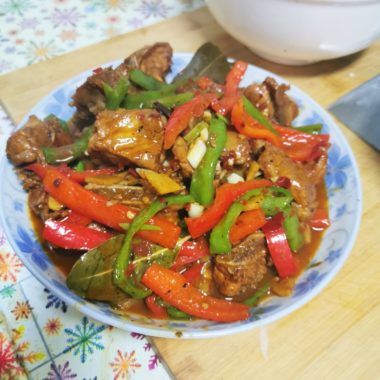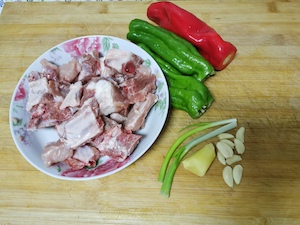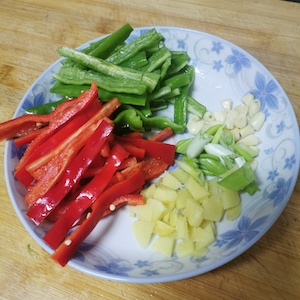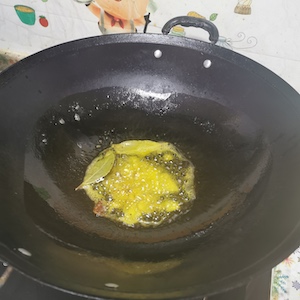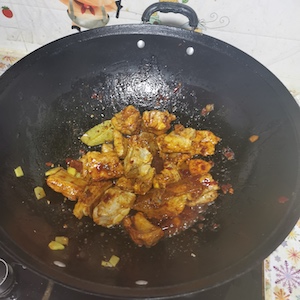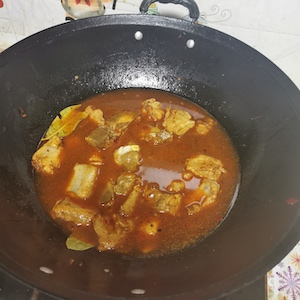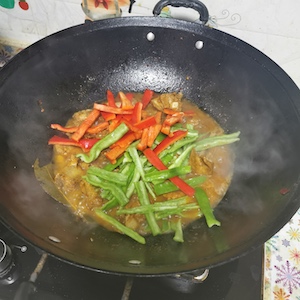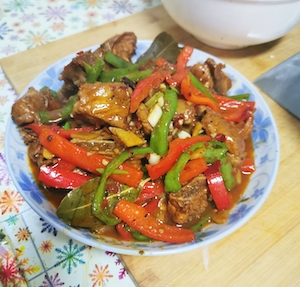Followers of our website know that I am studying to be a Chinese Cuisine chef at the New Oriental Cooking School. My teacher, Zhu Jinge taught us how to braise pork ribs, and I wanted to share this recipe with you. This is the first recipe on My Chinese Home Kitchen that uses braising, and I am excited to learn this traditional technique.
This Chinese Braised Pork Ribs recipe uses mild green and red peppers for color and texture, and introduces one of the many Chinese cooking techniques: braising. This is a brown-braise, which means we will brown the meat before braising it in a flavorful broth. Braising makes a tough piece of meat, like rib meat, fall-off-the-bone tender.

Braising pork ribs
Americans love barbecued ribs. True barbecue uses low heat and slow cooking to tenderize tough meat without drying it out. Braising ribs has the same tenderizing effect, and the liquid broth flavors the meat while it cooks.
First, we quickly blanch the ribs by putting them into cold water and bringing to a boil. Then we brown them in oil flavored with ginger, cinnamon, star anise, and bay leaves. Once browned, the meat is covered with water and simmered until tender. When the meat is fork tender, season the broth.
To finish with bright, crispy vegetables for color and texture, we add the peppers after the meat is done braising with a starch-water solution to thicken the broth, and stir-fry with bright oil to give the vegetables a glistening coat.
Chopping the ribs
The ribs for this recipe are cut into small portions, about 1/3 or ½ the length of the full rib bone. You can ask your butcher to do this, or you can do it yourself. To chop the ribs, you will need a sharp, stiff meat cleaver.
Starting with a rack of ribs, first peel the membrane off the back, as you would for a barbecue. Use a table knife to get under the membrane and pull up a corner. Then grasp the membrane with a paper towel and peel it off like pulling the tape off of a shipping carton.
Then stand the rack of ribs on its side and cut between the bones to separate each rib.
Finally, take each rib lengthwise, and with the cleaver, chop down through the bone at either the halfway point, or for larger ribs, at thirds.
Braised Pork Ribs
Equipment
- 1 wok
- 1 4 quart saucepan optional, for blanching the ribs
Ingredients
Ingredients
- 2 pork ribs
- 2 scallion
- ½ to 1 tbsp fresh ginger (7 to 15 ml), to taste
- 2 or 3 cloves fresh garlic to taste
- 2 bay leaf
- 2 star anise
- 2 g cinnamon
- 2 green peppers
- 1 red pepper
Seasoning
- starch water 1:1 starch to water, add as needed to thicken sauce
- salt
- ½ tsp sugar, white (granulated) 3 ml
- 1 tsp Shaoxing wine 5 ml
- 1 tsp Dark Soy sauce 5 ml
- 1.5 tsp Light soy sauce 7 ml
- 1 tbsp Oyster sauce 15 ml
- 1 tbsp Pixian Doubanjiang Bean Paste 15 ml
Instructions
Preparation
- Chop the ribs and wash them, then peel the onion, ginger, and garlic, and wash the green and red peppers.
- Chop the green onion, ginger and garlic, and cut the green peppers and red peppers into strips.
Cooking
- Place the ribs in cold water and bring to a boil to blanch, then remove the ribs and clean the pan.2 pork ribs
- Add oil to the wok, then add the ginger, star anise, cinnamon, and bay leaves and sauté in the oil.2 bay leaf, 2 star anise, 2 g cinnamon, ½ to 1 tbsp fresh ginger
- After sautéing, add the ribs and stir fry to brown the ribs.2 pork ribs
- Add the Pixian Doubanjiang bean paste and the light and dark soy sauces.1 tsp Dark Soy sauce, 1 tbsp Pixian Doubanjiang Bean Paste, 1.5 tsp Light soy sauce
- Add enough water to cover the ribs, and cook on low heat for 30 minutes. Then add the remaining seasonings (oyster sauce, cooking wine, sugar, and salt). Before adding the salt, taste the broth for saltiness.salt, ½ tsp sugar, white (granulated), 1 tbsp Oyster sauce, 1 tsp Shaoxing wine
- Add the green and red peppers, green onion, and garlic. Stir-fry for 30 seconds, then add the starch water a bit at a time and stir-fry to thicken the sauce.2 scallion, 2 or 3 cloves fresh garlic, 2 green peppers, 1 red pepper, starch water
- Then add 2 teaspoons (10ml) of oil to put a bright finish on the vegetables, stir-fry evenly for a few seconds to finish.
Video
Notes
- Use mild red and green peppers to this dish bright color.
- Doubanjiang bean paste and light soy sauce have a salty flavor. Before adding salt, test the flavor. Add salt to taste.
- Starch water is mixed 1 part corn or potato starch to 1 part water. It is used to thicken the sauce, and the more you add, the thicker the sauce becomes. This is similar to making gravy. Add a small amount at a time, and stir over the heat. If the sauce still seems thin, add a little more. The amount needed depends on how thick you want the sauce.
Nutrition
Do you enjoy My Chinese Home Kitchen?
We enjoy sharing these authentic home recipes with you. To learn more about My Chinese Home Kitchen, please visit our About page.
Please leave a comment, or SUBSCRIBE to our newsletter.
For more of our original videos, visit My Chinese Home Kitchen on YouTube and Rumble.


